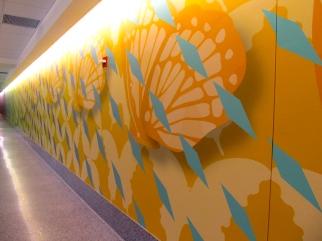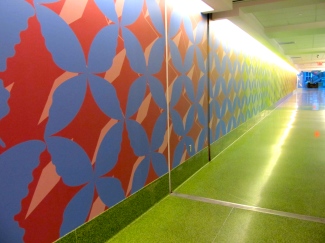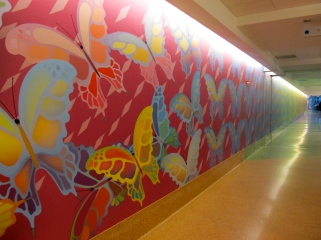Healing Art: One Part Imitation, One Part Imagination
by Jessica Ryan
According to a 2004 study administered by the Society for the Arts in Healthcare, The Joint Commission, and Americans for the Arts, 73% of healthcare facilities with arts programming displayed visual artwork on walls and in corridors (click here for a link to a pdf file of the study). As research has demonstrated, visual art in a patient’s environment can play an integral role in the healing process. A University of Central Florida study conducted in 2000 stated, “An excellent healing environment will reinforce excellent clinical quality, but an inferior environment can detract from fine clinical care” (Fottler). But how do healthcare institutions choose artwork that will foster an excellent healing environment for patients?
Ideally, healthcare institutions will choose art with both imitative and imaginative qualities. Both imitation and imagination have roles in healing art, and they interact to create a healing artistic experience for patients and visitors in healthcare environments.
One line of traditional thinking recommends that healing visual art should portray aspects of nature that depict images like tranquil waters, green vegetation, flowers, open spaces, and compassionate faces (Rollins 73). Such art is representational, imitating soothing scenery or situations. This approach is known as “evolutionary theory,” presenting nature imagery that evolution has made comforting and peaceful.
Emotional congruence theory, the other major theory affecting the selection of artwork in healthcare facilities, states that people’s inner moods shape their interactions with artwork (Guide to Evidence-Based Art). For instance, if a woman in a stressful state sees an abstract piece of art with an uncertain meaning, she likely will discern a dark meaning to correspond with her inner stressful state. Therefore, healthcare institutions will ideally display art that explicitly conveys positive and calming images.
By selecting representational artwork, healthcare institutions follow the advice of Plato, who advocates imitative art that benefits people by directing their thoughts away from the bad and toward the good. In a Platonic interpretation, an ambiguous artwork will harm patients by opening the door to negativity and dark thoughts, rather than helping such emotions to subside (Hofstadter 43). According to Plato, superior art imitates the ideal virtues of truth and goodness: “Let our artists rather be those who are gifted to discern the true nature of the beautiful and graceful; then will our youth dwell in a land of health, amid fair sights and sounds, and receive the good in everything; and beauty, the effluence of fair works, shall flow into the eye and ear, like a health-giving breeze from a purer region, and insensibly draw the soul from earliest years into likeness and sympathy with the beauty of reason” (Hofstadter 27).
If artists successfully imitate the beautiful in the universe, according to Plato’s thinking, they can bring health and healing to viewers of their artwork by teaching them virtue. Artwork imitating goodness and virtue should help healthcare patients to overcome destructive thought patterns that may accompany the diagnosis and treatment of an illness. Hence, healthcare institutions should prefer artwork imitating the ideas of health and courage to artwork conveying negativity.
In light of these musings, one might ask why it is imperative to have an element of imagination in healing art. To discover the importance of imagination, consider how individuals in healthcare facilities engage with their surroundings.
Many people in healthcare institutions face high levels of inner turmoil, but cultivating their imagination can help them to construct more rich and stimulating internal environments, using external stimuli to prompt aesthetic action within. Immanuel Kant speaks of this capacity of the imagination, “The imagination . . . is very powerful in creating another nature, as it were, out of the material that actual nature gives it. We entertain ourselves with it when experience becomes too commonplace, and by it we remold experience . . . so that the material supplied to us by nature in accordance with this law can be worked up into something different which surpasses nature” (Hofstadter 318). Individuals accordingly can use imagination to turn bleak circumstances into dynamic experiences.
Placing original or inventive objects in an environment aids the process of imagination by piquing individuals’ interest in the external environment and providing them with a starting point for imaginative musings. Prime objects for investigation generate interest by combining elements of the familiar with elements of the unknown or unexpected. Curiosity expert D. E. Berlyne explains that individuals find the greatest satisfaction in circumstances where they are exposed to something with which they are somewhat, but not completely, familiar (Rollins 76).
One successful healing artwork incorporating both the familiar and unfamiliar is the Transformation Corridor mural at the Children’s Hospital of Pittsburgh of UPMC. As visitors to the hospital travel through the hallway leading from the parking garage to the main lobby, they begin their journeys next to a wall painted with the cold blue of winter. A few steps later, diamond-shaped cocoons and pastel hues of yellow and orange emerge from the frigid winter to suggest the coming of spring and new life (Figure 1). Further along the wall, pale orange and yellow turn into more lively hues, such as the light green of summer, and the butterflies begin to take shape in their cocoons (Figure 2). Eventually the butterflies’ transformation is complete, and they burst forth from the pink wall in a vibrant medley of color (Figure 3).
Although using recognizable images of butterflies, the mural stimulates individuals’ imaginations by using vivid, expressive colors and larger-than-life forms. It uses familiar imagery in a new and creative manner to craft a therapeutic artistic experience. In a 2009 article from the Pittsburgh Post-Gazette, Dr. Andrew Urbach described the mural as “what the families told us they’re looking for, butterflies being the ultimate metaphor for transformation. You start out as a caterpillar and turn into this spectacular butterfly, and it’s a metaphor for illness to health, stress to no stress, anxiety to no anxiety.” Imitation points hospital visitors to the metamorphosis of the butterfly, and to the transformation they too might experience. Imaginative sizing and coloring heighten the effect of the mural by exaggerating the contrast between the cocoon and butterfly—sickness and health. Imitation and imagination together accomplish what neither could alone.
Ideally, imitation and imagination will always work together in a healthcare setting. According to aesthetician Anne Sheppard, people appreciate representational art that also allows for the engagement of the imagination (Sheppard 14). In order to enthrall viewers in a healthcare setting, an imitative piece of artwork should therefore leave room for the imagination or be complemented by the presence of a more imaginative artwork nearby. Sheppard illustrates the complementary relationship between imitation and imagination when she observes, “The successful artist plays with his audience’s expectations, satisfying some of them while disappointing others, using his work to modify existing expectations and create new ones” (Sheppard 99). Visitors to healthcare institutions need a point of reference for an artwork in order to value and understand it. Imitation of the natural world creates this point of reference. By meeting people at this point of reference, artists can then transport them through the realm of imagination to a meaningful and healing experience beyond the walls of the hospital environment.
_____
Be sure to read the first article in this TMD series on arts and healing, “Hospital Design: What Difference Does it Make?” by Jessica Ryan.
Also of interest, an article on art therapy written for TMD: “A Helper in Times of Trouble” by Janette Delgado
Last in this series, is an interview with Penny Brill — a violist with the Pittsburgh Symphony who created a music and wellness program. “The Healing Power of Music: An Interview with Penny Brill.”
_____
Print Works Cited
Fottler, M.D., et al. “Creating a healing environment: the importance of the service setting in the new consumer-oriented healthcare system.” Journal of Healthcare Management 45.2 (2000) : 91-107.
Hofstadter, Albert, and Kuhns, Richard, eds. Philosophies of Art & Beauty: Selected Readings in Aesthetics from Plato to Heidegger. 1964. Chicago: The University of Chicago Press, 1976.
Rollins, Judy. “Arousing Curiosity: When Hospital Art Transcends.” Health Environments Research & Design Journal 3.1 (2011) : 72-04.
Sheppard, Anne. Aesthetics: An introduction to the philosophy of art. Oxford: Oxford University Press, 1987.












